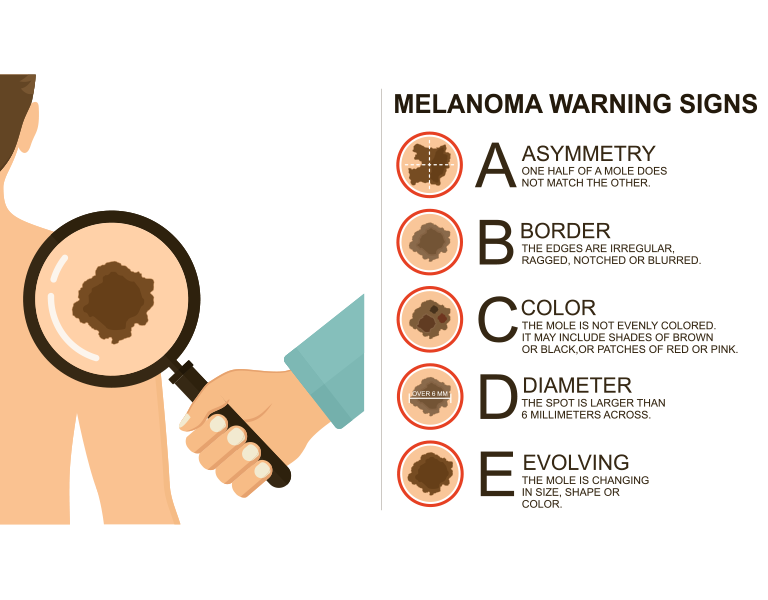
Skin cancer is one of the most common types of cancer worldwide, yet many people overlook its dangers. Among the different types, melanoma is the most aggressive and life-threatening. Unlike other skin cancers, melanoma can spread quickly to other parts of the body if left untreated. But the good news? Early detection can make a world of difference. In this blog, we will explore melanoma symptoms, risk factors, treatment options, and how you can protect yourself from it.
Synopsis
Understanding Melanoma
Melanoma: What Is It?
Melanoma is a type of skin cancer that develops in the melanocytes, the cells responsible for producing melanin (the pigment that gives skin its colour). It can appear anywhere on the skin, including areas not typically exposed to the sun, such as the palms, soles, and under the nails. Unlike other forms of skin cancer, melanoma has a higher tendency to spread to lymph nodes and internal organs, making early detection crucial.
Symptoms of Melanoma
One of the most effective ways to identify melanoma is by following the ABCDE rule:
-
A - Asymmetry: One half of the mole looks different from the other half.
-
B - Border: The edges are irregular, blurred, or jagged.
-
C - Color: Multiple colours (brown, black, red, blue, or white) are present.
-
D - Diameter: The mole is larger than 6mm (about the size of a pencil eraser).
-
E - Evolution: Changes in size, shape, or colour over time.
Other warning signs include itching, bleeding, or a new mole appearing suddenly. Early-stage melanoma can often be treated successfully, so regular self-examinations and dermatologist visits are vital.
Causes of Melanoma: Understanding the Risk Factors
There is no single cause of melanoma, but several factors increase the risk. Some of the primary causes of melanoma include:

1. UV Radiation Exposure
Excessive exposure to ultraviolet (UV) rays from the sun or tanning beds is the leading cause of melanoma. UV rays damage the DNA in skin cells, triggering abnormal growth.
2. Fair Skin and Genetics
People with fair skin, light hair, and blue or green eyes have less melanin, which means their skin is more vulnerable to UV damage. A family history of melanoma also increases the likelihood of developing it.
3. History of Sunburns
Having frequent sunburns, especially blistering sunburns in childhood, significantly raises melanoma risk.
4. Weakened Immune System
People with weakened immune systems, such as organ transplant recipients or those with autoimmune diseases, are more susceptible to melanoma.
5. Presence of Unusual Moles
Individuals with numerous or irregular moles (dysplastic nevi) are at a higher risk of developing melanoma.
Melanoma Risk Factors Overview
|
Risk Factor |
Description |
|
UV Radiation Exposure |
Prolonged sun exposure and tanning beds increase risk. |
|
Fair Skin & Genetics |
Light skin, hair, and a family history heighten the risk. |
|
History of Sunburns |
Severe sunburns, especially in childhood, increase the likelihood. |
|
Weakened Immune System |
Organ transplant recipients and autoimmune disease patients are more vulnerable. |
|
Unusual Moles |
Numerous or irregular moles raise the risk of melanoma. |
Diagnosing and Treating Melanoma
How Is Melanoma Diagnosed?
Doctors use various methods to diagnose melanoma, including:
-
Skin Examination: A dermatologist inspects suspicious moles or lesions.
-
Dermatoscopy: A special magnifying tool is used to assess mole patterns.
-
Biopsy: A sample of the affected skin is tested in a lab to confirm melanoma.
Melanoma Treatment Options
The treatment approach depends on the stage of melanoma. Here’s a breakdown:
1. Surgery
For early-stage melanoma, surgical removal of the tumour is the most common treatment. If caught early, this can be highly effective in preventing the spread.
2. Immunotherapy
For advanced cases, melanoma therapy such as immunotherapy is used to stimulate the immune system to attack cancer cells. Drugs like checkpoint inhibitors (Keytruda, Opdivo) have shown promising results.
3. Targeted Therapy
Certain melanomas have specific genetic mutations (e.g., BRAF mutation), which can be targeted with specialised drugs to slow tumour growth.
4. Chemotherapy and Radiation Therapy
While less commonly used, chemotherapy and radiation may be recommended for metastatic melanoma cases.
Preventing Melanoma: Protect Your Skin
Preventing melanoma is easier than treating it. Follow these key tips to reduce your risk:
-
Use Sunscreen Daily: Choose a broad-spectrum sunscreen with SPF 30 or higher and reapply every two hours when outdoors.
-
Avoid Tanning Beds: Artificial UV rays are just as harmful as natural sunlight.
-
Wear Protective Clothing: Wide-brimmed hats, sunglasses, and UPF clothing provide additional protection.
-
Regular Skin Checks: Perform monthly self-examinations and schedule annual dermatologist visits.
Conclusion: Get Expert Care at Manipal Hospitals Baner
Melanoma is a serious but preventable disease. By staying vigilant, protecting your skin, and seeking medical advice for any suspicious changes, you can lower your risk and improve early detection.
If you or a loved one are concerned about melanoma, Manipal Hospitals Baner offers world-class dermatology and oncology services for early diagnosis and advanced treatment. Our team of specialists in Manipal Hospital, Baner, ensures personalized care with state-of-the-art technology for optimal outcomes. Book a consultation today to take charge of your skin health!
Stay safe, stay informed, and protect your skin—it’s the only one you have!
FAQ's
Yes. Melanoma can develop in areas like the palms, soles, undernails, and even inside the mouth or eyes.
Melanoma can spread rapidly if left untreated. However, early-stage melanoma is often highly curable.
A family history of melanoma increases the risk, but environmental factors also play a major role.
The survival rate depends on the stage at diagnosis. Early detection offers a survival rate of over 90%.
Yes, melanoma can recur, especially if it is not detected early. Regular follow-ups are crucial to monitor recurrence.



















 5 Min Read
5 Min Read










.png)


